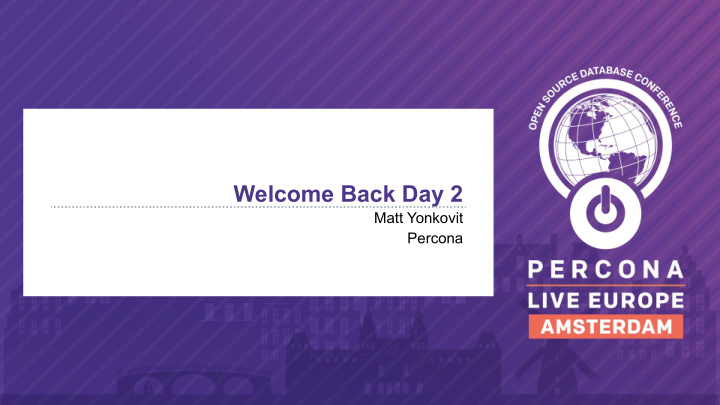



Welcome Back Day 2 Matt Yonkovit Percona
Percona Live: Lots of Learning and Fun! ● Learned tons about the current and future state of OSS databases ● Heard about all the cool stuff going on at Oracle MySQL ● Uncovered more about Hashi’s Cloud Operating Model ● Shared a great deal of content and learning over the last two days We still have a bit more for you... 2
Thank You Sponsors! 3
The Future Looked Bright... but are we there yet? 4
Self Realization: I am getting old. 5
Life Used to be Much Simpler Proprietary Open Source ● Oracle ● MySQL ● MS SQL Server ● PostgreSQL ● DB2 ● Sybase 6
The Future was Full of Promise... 7
With Lots of New Technology... ● Fully managed cloud ● Outages ● Automation ● Slowdowns ● AI and machine learning ● Security issues ● DBaaS ● Deep technical knowledge ● Better databases ● DBAs 8
It Was All Supposed to be So Easy! 9
Are We in the Future Yet? 10
Zero Outages? Not So Much! 11
Security No Longer a Concern? Not Really! 12
Easier to Get Started? Even More Confusing! 13
What Happened to the Future? 14
The future brought lots of new tools, but not solutions. You still have to know how to use the tools. 15
Undertrained, underqualified people with access to powerful technology. With great power comes great responsibility. 16
Who do you trust?
The In-Laws Meet Ernie and Terry 18
Who do you trust with your data and with technology?
Apathy and Blind Trust The destroyer of systems and breacher of security. 20
Shared Responsibility?
What is the Impact? The vast majority of database People don’t understand the breaches are caused by “Shared Responsibility Model” misconfigured or misunderstood technology ● Security ● Performance ● 1a/1b technology: ● Optimization MongoDB & Elasticsearch ● Architecture ● Misuse of public cloud provider Data is left open, unsecure, or technology untuned 22
Are they in a prison of their own design? What is “Fully Managed?” 23
Expectations are only getting higher! 24
What Happens When Expectations Aren’t Met? Netflix, Snapchat, or Facebook go down 25
Imagine the Impact to Millions of Users... ● Hospitals ● Banks ● Government ● Manufacturing ● Emergency Services … or Twitter! 26
What are the expectations In 2014 Akanami said 49% of people wait 2 seconds or less. Amazon once estimated that every additional second of load time costs them 1.6B a year. A 2016 study by google estimated you lose 53% of your mobile traffic if you don’t respond within 3 seconds. According to a 2017 study by Kissmetrics: 40% of people will abandon a website if it takes more then 3 seconds. A 2019 study by Quantum Metric says 36% of users will find alternatives if a website is slow.
Missing Expectations ● 44% report having slowdowns related to their database in production ● 20% had unplanned database downtime ● 14% said they rolled bad code into production 29
How Users Respond to Outages ● People have zero tolerance for an outage ● People can’t wait for data to become available. They need it now or they WILL find an alternative. ● A company’s reputation matters, and these small things can have a huge impact on how their brand is perceived 30
What Does This Mean for You? ● People will blame you for missed expectations ○ Databases often are overlooked by the application development teams, yet they are critical to performance ● Scale by pay is becoming more common. ○ Yet, there is little to no understanding that paying more doesn’t protect you from issues ● Issues aren’t going anywhere ○ We are just kicking the can down the road ● Everyone is overloaded ○ We are all looking for ways to reduce workload, and automation seems like an easy answer… but is it? 31
Automation: A multiplier of both good and bad. 32
Does Automation Help or Hurt? ● Many major outages are caused by automation - the automation of something bad ● What could have been a relatively small outage, turns into a half or full day outage once the bad things are replicated ● Workload is actually increased. Instead of fixing one server, you have to fix 1000’s of them! ● Deadlines still have to be met. The speed needed to deploy can lead to cutting corners in testing, creating more issues. 33
We strived for simplification and ease of use, but we missed the mark. 34
How do we make this complex ecosystem easier to use while still celebrating the powerful differences of each provider and tool? 35
Focus on These Key Areas ● Shared responsibility ○ Database vendors and cloud providers offer you many tools, but you have to learn how to use them properly ● No blind trust ○ Educate yourself and clearly understand each technology’s power and limitations before implementing them ● Mitigate risk ○ Nothing is bulletproof. Have redundancies in place. Plan for a bad day. ● Understand your users ○ Get to know your user’s expectations and then design your systems to meet them and fulfill their needs ● Use automation wisely ○ Remember that you can automate both good and bad things. Always test, verify, and then adjust your automation accordingly. 36
Applications are living breathing entities that evolve and change. You need to evolve and change with them. 37
Recommend
More recommend